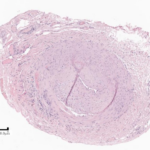Alan. H. Mallace, MD, FACR, looks back at a half-century of practicing rheumatology & looks ahead to what the future might hold for fellows starting out today.


Alan. H. Mallace, MD, FACR |
Alan. H. Mallace, MD, FACR, looks back at a half-century of practicing rheumatology & looks ahead to what the future might hold for fellows starting out today.

Daniel F. Battafarano, DO, MACP, MACR |
The year before my hike, I was extremely busy with various ACR workforce issues; meetings; presentations, locally, regionally and nationally; juggling medical missions and more. However, I had blocked time in my calendar over one year in advance to hike the Camino de Santiago in Spain with a long-time U.S. Army buddy. I met Pat…

Tom Berry, DO |
The transition from being a rheumatology fellow to being in private practice is significant. As I reflect on the past two years, I want to share my observations and begin a conversation about how to prepare rheumatology fellows for careers as practicing rheumatologists. The difference between learning about rheumatology and practicing rheumatology is nuanced. Upon…

Daniel H. Solomon, MD, MPH, & Andrew Concoff, MD, FACR |
Guest columnists Dr. Daniel Solomon & Dr. Andrew Concoff discuss the potential of technology, such as mobile health apps, to enhance remote care & improve access for underserved patients.

Daniel H. Solomon, MD, MPH, & Andrew Concoff, MD, FACR |
Over our 25 years as rheumatologists, care has advanced greatly. We each completed our rheumatology training in the late 1990s when both infliximab and etanercept first arrived on the U.S. market, ushering in the era of biologics in rheumatology. Since this time, our greater understanding of the immunologic basis of many rheumatic diseases has translated…

The story of one patient whose research participation helped establish VEXAS as a diagnosable condition.

Moayad Alqazlan, MBBS, Vidhya Nair, MBBS, MD, & Michael A. Seidman, MD, PhD |
At the end of 2023, the Society for Cardiovascular Pathology (SCVP) published consensus guidelines on the diagnostic approach to temporal artery biopsy.1 Through this publication, SCVP hopes to bring more uniformity to the processing, interpretation and reporting of these specimens, taking into consideration the most up-to-date literature available. These guidelines have obvious impact on clinical…

Donald Thomas, MD, FACP, FACR, RhMSUS, & Jason Liebowitz, MD |
Think about it. Most rheumatology labs are stuck in the 1960s. Translational biomarker research looks excellent on paper and in theory. However, many barriers exist from the bench to the bedside. This article highlights this problem for the rheumatology community and proposes practical solutions. Case in Point For an example, let’s examine systemic lupus erythematosus…

“When you get a good mentor, don’t let ’em be the one that got away.” Richard Brasington Jr., MD, FACP, MACR, told me this about a decade ago when I was a rheumatology fellowship applicant and first met him. It was clear the statement was influenced by his love of fishing. Dr. Brasington’s office was…

Carlos Antonio Moura, MD, with Carlos Geraldo Moura, PhD |
I am often asked by medical students, resident physicians and—especially—patients, what is rheumatology? When students ask me why I chose to be a rheumatologist, I answer that I have never been in love with pathologies, such as rheumatoid arthritis, spondyloarthritis, gout, osteoporosis, systemic lupus erythematosus or vasculitis. In fact, I chose rheumatology because I love…